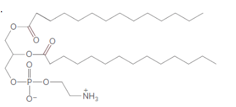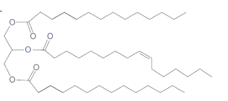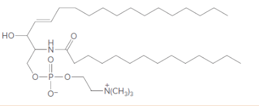
CONNECT IA GENERAL ORGANIC&BIO CHEMISTRY
4th Edition
ISBN: 9781260562620
Author: SMITH
Publisher: MCG
expand_more
expand_more
format_list_bulleted
Concept explainers
Textbook Question
Chapter 19.6, Problem 19.11P
Identify the components of each lipid and classify it as a triacylglycerol, a phosphoacylglycerol, or a sphingomyelin. Classify any phosphoacylglvcerol as acephalin or lecithin.
a.
b.
c.
Expert Solution & Answer
Want to see the full answer?
Check out a sample textbook solution
Students have asked these similar questions
At 0oC and 1 atm, the viscosity of hydrogen (gas) is 8.55x10-5 P. Calculate the viscosity of a gas, if possible, consisting of deuterium. Assume that the molecular sizes are equal.
Indicate the correct option for the velocity distribution function of gas molecules:a) its velocity cannot be measured in any other way due to the small size of the gas moleculesb) it is only used to describe the velocity of particles if their density is very high.c) it describes the probability that a gas particle has a velocity in a given interval of velocitiesd) it describes other magnitudes, such as pressure, energy, etc., but not the velocity of the molecules
Indicate the correct option for the velocity distribution function of gas molecules:a) its velocity cannot be measured in any other way due to the small size of the gas moleculesb) it is only used to describe the velocity of particles if their density is very high.c) it describes the probability that a gas particle has a velocity in a given interval of velocitiesd) it describes other magnitudes, such as pressure, energy, etc., but not the velocity of the molecules
Chapter 19 Solutions
CONNECT IA GENERAL ORGANIC&BIO CHEMISTRY
Ch. 19.1 - Prob. 19.1PPCh. 19.1 - Prob. 19.1PCh. 19.2 - (a) Draw a skeletal structure for each fatty acid....Ch. 19.2 - Prob. 19.2PCh. 19.2 - Prob. 19.3PCh. 19.3 - Prob. 19.3PPCh. 19.3 - One component of jojoba oil is a wax formed from...Ch. 19.3 - Explain why beeswax is insoluble in water,...Ch. 19.3 - Prob. 19.6PCh. 19.4 - Prob. 19.4PP
Ch. 19.4 - Prob. 19.7PCh. 19.4 - Prob. 19.8PCh. 19.5 - Prob. 19.5PPCh. 19.5 - Review Section 5.2 on balancing chemical...Ch. 19.5 - Prob. 19.10PCh. 19.6 - Prob. 19.6PPCh. 19.6 - Identify the components of each lipid and classify...Ch. 19.7 - Prob. 19.12PCh. 19.7 - Prob. 19.13PCh. 19.7 - Prob. 19.14PCh. 19.8 - (a) Label the rings of the steroid nucleus in...Ch. 19.8 - Prob. 19.16PCh. 19.8 - Prob. 19.17PCh. 19.9 - Prob. 19.18PCh. 19.9 - Prob. 19.19PCh. 19.10 - Prob. 19.20PCh. 19.11 - Prob. 19.21PCh. 19.11 - Prob. 19.22PCh. 19 - Prob. 23PCh. 19 - Prob. 24PCh. 19 - Prob. 25PCh. 19 - Prob. 26PCh. 19 - Prob. 27PCh. 19 - Prob. 28PCh. 19 - Rank the fatty acids in order of increasing...Ch. 19 - Prob. 30PCh. 19 - Prob. 31PCh. 19 - Prob. 32PCh. 19 - Prob. 33PCh. 19 - Prob. 34PCh. 19 - Draw the structure of a wax formed from palmitic...Ch. 19 - Draw the structure of a wax formed from a...Ch. 19 - What hydrolysis products are formed when each wax...Ch. 19 - What hydrolysis products are formed when each wax...Ch. 19 - Prob. 39PCh. 19 - Prob. 40PCh. 19 - Draw a triacylglycerol that fits each description:...Ch. 19 - Draw a triacylglycerol that fits each description:...Ch. 19 - Draw the structure of a triacylglycerol that...Ch. 19 - Draw the structure of a triacylglycerol that...Ch. 19 - Consider the following four types of compounds:...Ch. 19 - How do fats and oils compare with respect to each...Ch. 19 - For the food product shown in the accompanying...Ch. 19 - For the food product shown in the accompanying...Ch. 19 - Answer the following questions about the given...Ch. 19 - Answer the following questions about the given...Ch. 19 - Draw the products formed when each triacylglycerol...Ch. 19 - Draw the products formed when each triacylglycerol...Ch. 19 - Which of the following are phospholipids: (a)...Ch. 19 - Prob. 54PCh. 19 - Prob. 55PCh. 19 - Prob. 56PCh. 19 - wIn transporting molecules or ions across a cell...Ch. 19 - Prob. 58PCh. 19 - Draw the structure of the anabolic steroid...Ch. 19 - Draw the structure of the anabolic steroid...Ch. 19 - Why must cholesterol be transported through the...Ch. 19 - Describe the role of HDLs and LDL5 in cholesterol...Ch. 19 - Prob. 63PCh. 19 - Prob. 64PCh. 19 - (a) Draw the structure of an estrogen and an...Ch. 19 - (a) Draw the structure of an androgen and a...Ch. 19 - What are the similarities and differences between...Ch. 19 - Why aren’t prostaglandins classified as hormones?Ch. 19 - What two structural features characterize all...Ch. 19 - List three biological functions of prostaglandins...Ch. 19 - Explain why aspirin and celecoxib differ in how...Ch. 19 - How does zileuton treat the cause of asthma, not...Ch. 19 - Answer each question with regard to vitamins A and...Ch. 19 - Answer each question in Problem 19.73 for vitamins...Ch. 19 - Give an example of each type of lipid. a. a...Ch. 19 - Give an example of each type of lipid. a. a...Ch. 19 - Consider each of the following components: [1]...Ch. 19 - Consider each of the following components: [1]...Ch. 19 - Block diagrams representing the general structures...Ch. 19 - For each block diagram in Problem 19.79, label the...Ch. 19 - Prob. 81PCh. 19 - Prob. 82PCh. 19 - Prob. 83PCh. 19 - Prob. 84PCh. 19 - Prob. 85PCh. 19 - Prob. 86PCh. 19 - Can an individual survive on a completely fat-free...Ch. 19 - Prob. 88PCh. 19 - Prob. 89PCh. 19 - Prob. 90PCh. 19 - Prob. 91PCh. 19 - Prob. 92PCh. 19 - Prob. 93CPCh. 19 - Prob. 94CP
Knowledge Booster
Learn more about
Need a deep-dive on the concept behind this application? Look no further. Learn more about this topic, chemistry and related others by exploring similar questions and additional content below.Similar questions
- The number of imaginary replicas of a system of N particlesA) can never become infiniteB) can become infiniteC) cannot be greater than Avogadro's numberD) is always greater than Avogadro's number.arrow_forwardElectronic contribution to the heat capacity at constant volume A) is always zero B) is zero, except for excited levels whose energy is comparable to KT C) equals 3/2 Nk D) equals Nk exp(BE)arrow_forwardPlease correct answer and don't used hand raitingarrow_forward
- Calculate the packing factor of CaTiO3. It has a perovskite structure. Data: ionic radii Co²+ = 0.106 nm, Ti4+ = 0.064 nm, O² = 0.132 nm; lattice constant is a = 2(rTi4+ + ro2-). Ca2+ 02- T14+ Consider the ions as rigid spheres. 1. 0.581 or 58.1% 2. -0.581 or -58.1 % 3. 0.254 or 25.4%arrow_forwardGeneral formula etherarrow_forwardPlease provide the retrosynthetic analysis and forward synthesis of the molecule on the left from the starting material on the right. Please include hand-drawn structures! will upvote! Please correct answer and don't used hand raitingarrow_forward
- Please provide the retrosynthetic analysis and forward synthesis of the molecule on the left from the starting material on the right. Please include hand-drawn structures! will upvote!arrow_forward(please correct answer and don't used hand raiting) Please provide the retrosynthetic analysis and forward synthesis of the molecule on the left from the starting material on the right. Please include hand-drawn structures! will upvote!arrow_forwardCaTiO3 has a perovskite structure. Calculate the packing factor.Data: ionic radii Co+2 = 0.106 nm, Ti+4 = 0.064 nm, O-2 = 0.132 nm; lattice constant is a = 2(rTi4+ + rO-2).(a) 0.581(b) -0.581(c) 0.254(d) -0.254arrow_forward
arrow_back_ios
SEE MORE QUESTIONS
arrow_forward_ios
Recommended textbooks for you
 ChemistryChemistryISBN:9781305957404Author:Steven S. Zumdahl, Susan A. Zumdahl, Donald J. DeCostePublisher:Cengage Learning
ChemistryChemistryISBN:9781305957404Author:Steven S. Zumdahl, Susan A. Zumdahl, Donald J. DeCostePublisher:Cengage Learning ChemistryChemistryISBN:9781259911156Author:Raymond Chang Dr., Jason Overby ProfessorPublisher:McGraw-Hill Education
ChemistryChemistryISBN:9781259911156Author:Raymond Chang Dr., Jason Overby ProfessorPublisher:McGraw-Hill Education Principles of Instrumental AnalysisChemistryISBN:9781305577213Author:Douglas A. Skoog, F. James Holler, Stanley R. CrouchPublisher:Cengage Learning
Principles of Instrumental AnalysisChemistryISBN:9781305577213Author:Douglas A. Skoog, F. James Holler, Stanley R. CrouchPublisher:Cengage Learning Organic ChemistryChemistryISBN:9780078021558Author:Janice Gorzynski Smith Dr.Publisher:McGraw-Hill Education
Organic ChemistryChemistryISBN:9780078021558Author:Janice Gorzynski Smith Dr.Publisher:McGraw-Hill Education Chemistry: Principles and ReactionsChemistryISBN:9781305079373Author:William L. Masterton, Cecile N. HurleyPublisher:Cengage Learning
Chemistry: Principles and ReactionsChemistryISBN:9781305079373Author:William L. Masterton, Cecile N. HurleyPublisher:Cengage Learning Elementary Principles of Chemical Processes, Bind...ChemistryISBN:9781118431221Author:Richard M. Felder, Ronald W. Rousseau, Lisa G. BullardPublisher:WILEY
Elementary Principles of Chemical Processes, Bind...ChemistryISBN:9781118431221Author:Richard M. Felder, Ronald W. Rousseau, Lisa G. BullardPublisher:WILEY

Chemistry
Chemistry
ISBN:9781305957404
Author:Steven S. Zumdahl, Susan A. Zumdahl, Donald J. DeCoste
Publisher:Cengage Learning

Chemistry
Chemistry
ISBN:9781259911156
Author:Raymond Chang Dr., Jason Overby Professor
Publisher:McGraw-Hill Education

Principles of Instrumental Analysis
Chemistry
ISBN:9781305577213
Author:Douglas A. Skoog, F. James Holler, Stanley R. Crouch
Publisher:Cengage Learning

Organic Chemistry
Chemistry
ISBN:9780078021558
Author:Janice Gorzynski Smith Dr.
Publisher:McGraw-Hill Education

Chemistry: Principles and Reactions
Chemistry
ISBN:9781305079373
Author:William L. Masterton, Cecile N. Hurley
Publisher:Cengage Learning

Elementary Principles of Chemical Processes, Bind...
Chemistry
ISBN:9781118431221
Author:Richard M. Felder, Ronald W. Rousseau, Lisa G. Bullard
Publisher:WILEY
Lipids - Fatty Acids, Triglycerides, Phospholipids, Terpenes, Waxes, Eicosanoids; Author: The Organic Chemistry Tutor;https://www.youtube.com/watch?v=7dmoH5dAvpY;License: Standard YouTube License, CC-BY